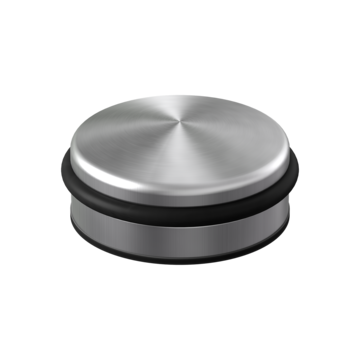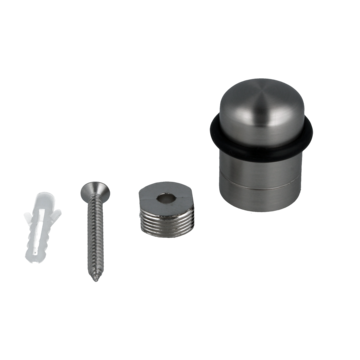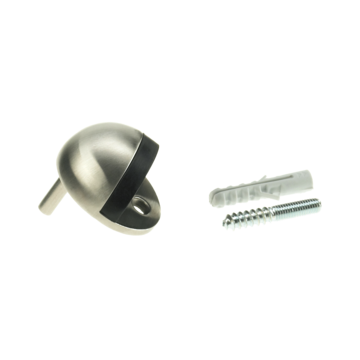Door stop guide
Door stops prevent the slamming of doors or stop them. Door handles and walls behind the door are not damaged during careless closing thanks to them. What types of Door stops there are and which are best suited for your purpose, reveals our guide.
We answer the following questions in this guide:
- Why should you use door stoppers?
- What material are doorstops made of?
- What types of door stoppers are there?
Door stop made of different material
Door stops can be made of different materials. Depending on the heaviness of the respective materials, they are suitable for different types of mounting.
Stainless steel Door stop
Door stops made of Stainless steel are quite heavy, weighing up to one Kilogram, and due to their own weight usually do not need to be glued or screwed to the Floor. If the door is very heavy and the door stop could therefore still slip, you can additionally fix Stainless steel Door stoppers with a non-slip base of Silicone to prevent slipping away.
Door stop made of plastic, rubber or Silicone
Door stops are also available in shock-absorbing materials such as Silicone, plastic or rubber. Since these materials are relatively light, they are well suited for light doors, such as Glass doors. Additional fastening by screws or glue should not be dispensed with for lightweight material. Rubber bands are particularly suitable for door clips that are hung around the Door handle to hold the door open.
Fabric Door stop
Door stops made of fabric are also suitable for doors without a Door handle, which can not hit the wall and damage it. These sandbag-like stoppers are simply placed on the Floor behind the door. When it is opened, it cannot hit the wall. When the door is closed, the fabric Door stop can be placed flush against the bottom of the door for additional draught resistance.
Different types of Door stops
Floor Door stop
Door stops are often placed on the Floor. Attachment differs: door stops that can not be firmly placed by their own weight, must be additionally fixed in the floor with glue or screws. Thus, some Door stops have a thread, which is placed in the center. Another option is to fix them to the Floor using glue. Heavy Stainless steel Door stops can simply be placed on the Floor and require None further fixation.
Door wedges
Door wedges are made of plastic, Stainless steel or Wood. The wedge-shaped Door stops are placed behind the door and prevent it from closing or banging against the wall. As for the heavy Stainless steel Door stops, Door stops can also be placed flexibly.
Magnet Door stop
Door stops with magnet consist of two parts. A magnetic ring and a counterpart, which is often additionally spring-loaded. The Stopper is screwed into the Floor and the Magnetic Ring is screwed in a suitable place at the lower end of the door.
Door holder
Door stops are often installed in public buildings. The door can be opened and hooked into a construction in the Floor or on the wall. Thus, it remains permanently open and can no longer slam shut.
Door damper for mounting on the wall
Door dampers are mounted behind the door. Screwed or glued, they dampen the impact of the door on the wall. Also in this variant, the door damper can be made of plastic, Stainless steel with rubber cap or completely made of rubber.
Door damper to attach to the door
Door dampers can also be mounted directly on the door . This variant is particularly useful when the door can not be opened very wide due to lack of space. A small rubber part can be easily glued to the desired place on the door and prevents hard impact of the door on the wall.
What you should consider before buying a doorstop
Doorstops play an important role in everyday life by effectively holding doors open or preventing doors from hitting walls or furniture. Here are some tips to help you find the perfect doorstop for your needs:
1. determine the intended use
Before you buy a doorstop, think about what you need it for. Do you want it to hold a door open or prevent a door from slamming? Your needs will determine the type of doorstop you should choose.
2. choose the right type
There are different types of door stoppers:
- Floor doorstops: are fitted to the floor and are ideal for holding doors open or preventing them from hitting the wall.
- Wall door stoppers: Are fixed to the wall and prevent the door handle from damaging the wall.
- Door handle buffer: A simple buffer that can be placed on the door handle to protect the wall from damage.
- Wedge door stoppers: Simply pushed under the door to keep it open. They are mobile and can be easily moved from room to room.
3. material and design
Doorstops are available in various materials such as rubber, metal, wood or plastic. Choose a material that matches the aesthetics of your room and offers the desired functionality. Some materials, such as rubber, offer a better grip on different floors.
4. take into account the condition of the door and floor
The type of floor covering (carpet, wood, tiles) can influence which door stopper works best. The weight and size of the door also play a role in choosing the right door stopper.
5. safety aspects
Make sure the doorstop is secure and stable to prevent it from slipping, especially if there are children or pets in the household.
6. simplicity of installation
Some doorstops require installation with screws or adhesive. Consider how easy it is to install the doorstop and whether you prefer to avoid installations that could cause permanent changes or damage.
7th prize
Doorstops vary in price depending on the material, design and brand. Set a budget, but keep in mind that a higher price often means better quality and durability.
The most frequently asked questions about Door stops
What questions are most frequently asked about Door stops? We found out using software that analyzes the questions people ask voice assistants from Apple, Google and others. We answer five of them here:
Why Door stop?
To ensure that doors remain open or to protect against a hard impact, it is worth using a Door stop. Especially for Glass doors, which are more easily broken if the impact is too hard. Thus, the door leaf and the wall are not damaged. Glass doors in particular are protected with a Door stop.
What material are Door stops made of?
Door stops can be made of Stainless steel, Metal, Plastic, Rubber or Silicone. Door wedges, in addition to plastic, are often made of Wood. Bag-like Door stops that are placed on the Floor are usually made of fabric.
What are the types of Door stops?
Floor and wall Door stops: To prevent the door from hitting the wall, attach Door stops to the floor or wall. For this purpose, they are screwed or glued. Some are additionally equipped with magnets to stop the door. There are also Floor door stops, which stop the door by its own weight, Without being fastened. Door wedges are only placed on the Floor and prevent the door from falling into the lock case unintentionally. Risk of breakage: None should be used for Glass doors. Soft rubber door stops are suitable for glass.
How heavy are Door stops?
There are heavy Door stops made of Metal, which stop doors on the basis of their own weight and can weigh up to a kilo or more. Door wedges made of plastic or Wood are only a few grams. As with door stops for screwing, the weight due to fastening with screws or wedging here plays None.
What are the colors of Door stops?
Door stops are often made of silver Stainless steel. Door stops made of plastic are available in almost any Color. For a harmonious overall appearance, it is worth considering the Color of the glass door and door fittings.


